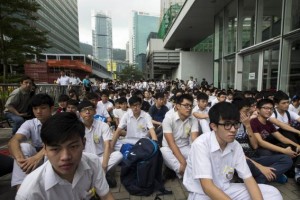Author: Courtney J. Fung, HKU
(Courtesy East Asia Forum) — Many think that compromise between China and Hong Kong protesters is impossible. Protests continue to swell and China is holding firm on its position that the designation of the 2017 electoral ballot is ultimately under Beijing’s control. But in the past there have been multiple instances of compromise between China and Hong Kong protesters after public stand-offs over similarly sensitive issues. And compromise is again a feasible option, well worth considering now.

The street marches against the proposed Article 23 anti-subversion laws in 2003 and the student sit-in against patriotic national education reforms in 2012 are recent examples of China–Hong Kong flash points that ended in compromise. Those incidents contained the same critical factors we see today: tensions between a Hong Kong identity and a proudly Chinese one; distrust over patriotism to the Chinese state; and concerns about Hong Kong’s greater democratic future.
In 2003 as in 2012, both sides were able to reach a compromise: discussions of the contested proposals were shelved for an indefinite period, and day-to-day politics went on as before. Indeed, the ability to compromise and tolerate differences of opinion between China and Hong Kong citizens is highlighted each year with the burgeoning vigils and peaceful protests on 4 June in commemoration of Tiananmen. These incidents illustrate that both the Hong Kong people and China can be pragmatic about establishing workarounds — getting both sides to find some type of middle ground even when their interests appear zero-sum.
Still, the current protest, which is taking place in business and tourist hotspots around the city, is more complicated than prior incidents. First, what initially started as a class boycott by student protesters — which then joined with the Occupy Central with Love and Peace protesters — has now become a genuine people’s movement. Hong Kong citizens who were apathetic to calls for true democracy were drawn to the streets after the repeated use of tear gas last Sunday.
Second, protesters have already called the authorities’ bluff: crowds remained after tear gas was fired, effectively diminishing the deterrent value of the harshest tactic in the local government’s toolkit. Third, there is also the problem of the multiple demands made of the Hong Kong government and China by the protesters — which have included: the prompt release of three leading student activists; the resignation of Chief Executive CY Leung; revisions to the 2017 electoral reforms decreed by China; and complete and universal suffrage to include civil nomination in 2017. There is still little significant coordination between the three major protest groups over these demands, making it difficult to determine the priorities assigned to each. And unlike some of the previous protests, the civil disobedience of the last week is by definition an extra-legal measure taken without government approval — a sign that people have given up working within the system to find political solutions.
As the Hong Kong protests have gone from stand-off to sit-in, and with solidarity protests popping up in other major cities, it is increasingly in China’s interest to take steps towards discussions with the protesters. The longer protests remain peaceful and orderly, the more moral firepower protesters have to disrupt China’s authority over Hong Kong. It is also in the interest of the protesters to think about their strategy beyond blocking the streets. Protesters have the most negotiating power now that the crowds are in the thousands.
So what can be done?
Though it won’t be easy, both sides can take measures towards compromise.
First, the protests should be approached by authorities as a long game. Decoupling crowd dispersal from other, political goals will help maintain calm, creating the space for compromise to occur. This is a new strategy for the Leung administration, with the Hong Kong police now monitoring crowds and negotiating humanitarian corridors instead. Second, both sides should recognise that face-saving measures have value once again in settling public discontent. Just as the Hong Kong security chief resigned after public discontent in 2003, senior local officials may have to fall on their professional swords to reduce protesters’ pressure.
Such measures are important for China as they would create the political space to say that Hong Kong officials are committed to making concessions. Protesters should accept such moves as they would advance the potential for compromise. China in turn should acknowledge public discontent in the city. Its initial hardline approach only stoked public discontent, and a pragmatic goodwill gesture would help the protest leaders to establish both clear leadership roles among their factions and a hierarchy of their remaining goals, in order to approach China.
Ultimately, these difficult steps to compromise could reduce tensions between the parties, and could prove to be invaluable in the long run. Similar measures have worked before. Neither side has any interest in seeing an escalation of pressure or the potential for violence, making compromise a proposition worthy of serious consideration.
Dr Courtney J. Fung is Assistant Professor at the Department of Politics and Public Administration, The University of Hong Kong.
See: http://www.eastasiaforum.org/2014/10/04/can-the-hong-kong-protesters-and-china-compromise/







